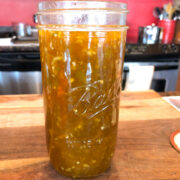What can you can in a water bath canner?
Water bath canning is the process for canning pickles, fruits, jams, and preserves. Pressure canning is used for meats, sauces, seafood, or poultry. The difference between water bath canning vs pressure canning is foods with high acidity are canned with the water bath process and foods with low acidity are canned with the pressure canning process.

Items needed for Water Bath Canning
- Canning pot
- Glass canning jars
- Lids
- Bands (if the lids are not coated in rubber)
- Wooden spoon
- Ladle
- Funnel
Optional items
- Jar lifting rack
- Jar tongs
- Rubber spatula
I have the water bath canning pot, the lifting rack, funnel, rubber spatula, and hot jar tongs. You can find them online or most stores like Wal-Mart, Target, etc. I found a canning kit at a local thrift store; which are great places to find used kitchen products.
Water Bath Canning Process
The first thing you want to do is place enough water in the pot to completely cover the canning jars you'll be using. Bring the water to a boil; you'll need to have water set aside to account for evaporation. While the water is coming to a boil, wash the canning jars and lids in warm soapy water and rinse.
I know what you're thinking. What about sterilization? Well, in doing my research, sterilization of the jars and lids has not been necessary for decades as long as the canning process is 10 minutes or longer. Now that you have washed the jars and lids, you can begin preparing your canned food ingredients. Make sure they are washed, cut to the appropriate size, and that you have your recipe handy. How far you fill your jars depends on the recipe you are following. Some recipes call for headspace of anywhere between ¼ inch from the top to 1 ½ inch from the top. Too much headspace can cause a weak seal and a lower vacuum. Too little headspace can cause the food to become lodged under the seal and create a seal break.
Use these guidelines for headspace:
Juices, jams, jellies, and relishes need ¼ inch Fruits, tomatoes and pickles need ½ inch.
After you have filled the jars to the appropriate levels, place the lid on the jar and tighten to a finger-tight fit. Now you are ready to carefully lower the filled jars into the boiling water. Fully submerge the jars in the boiling water. If the jars on not fully submerged, add more hot water to cover the jars. Remember if you didn't sterilize your jars, you need to boil for 10 minutes or longer.
Make sure you follow your recipe instructions. When your canning time has come to an end, turn off the heat, carefully remove the pot from the burner and allow everything to rest for 5 minutes. This allows settling and will reduce the siphoning of any liquid. After the resting period, remove the jars and place them on a towel to avoid temperature displacement and potentially breaking the hot jars. It's important you don't tip the jars or shake them.
Finally!
If you're anything like me, you'll be impatient and excited. So you need to be extra vigilant that you don't mess with the jars. You can, of course, check on them every now and then by LOOKING at them. The canning process was done properly if you hear the lids popping. Check the lids to see if the round dimple in the middle of the lid has sunken in; this indicates the lids popped and the seal is good. Move the completely cooled jars to your storage area. Congratulations on your Water Bath Canning Process! Be sure to let me know what your canning results were.
Other canning ideas
- Also known as pickled jalepeños, my Jalapeño Escabeche recipe is a great example of water bath canning.
- Canning your spring harvest is a great way to have roasted heirloom tomato sauce on hand during the winter months.
- A simple marinara sauce for your pasta can also be canned and stored in your pantry.


















Comments
No Comments